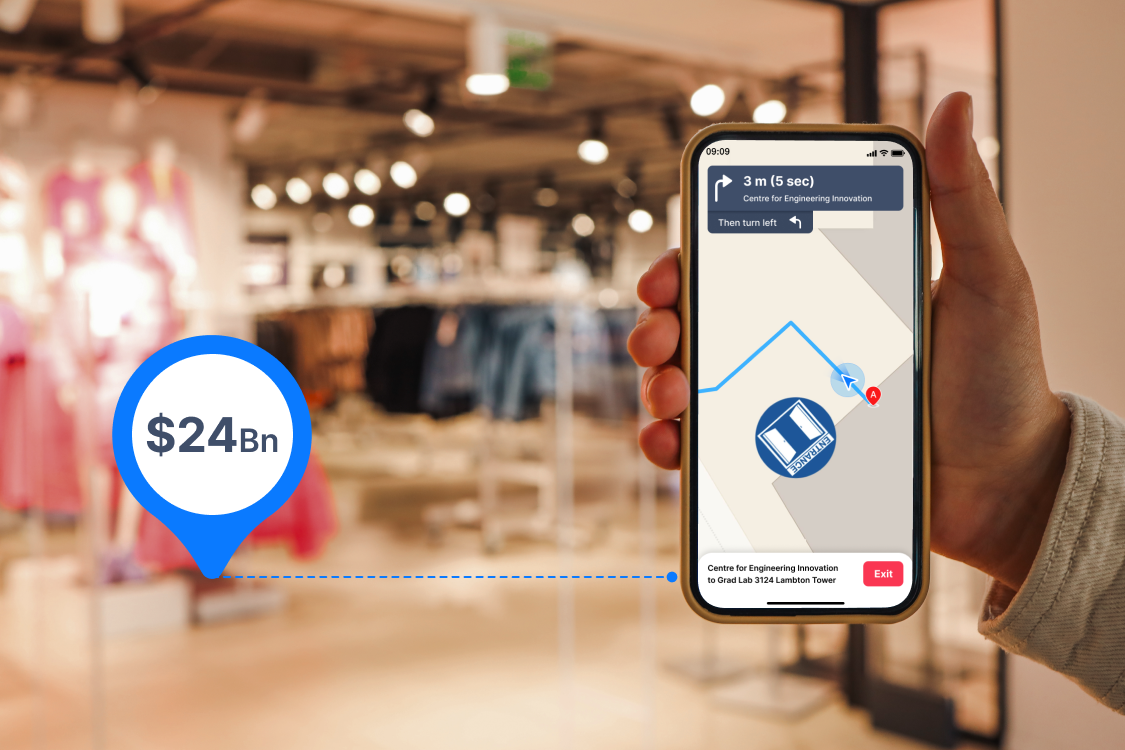Technology Trends

Indoor location tracking is now one of the most promising technologies that is revolutionizing the world. Consider that it is as simple to get around large buildings as if they were streets and use Google Maps for that purpose. This is what indoor location technology holds for the future, and the market is expected to grow from $8.8 billion in 2022 to $24 billion in 2027, with a CAGR of 22.4%. This blog will examine the factors behind this growth, the opportunities it brings, the risks that are likely to be realized, and the future of location tracking market.
The Evolution of Indoor Location Services
Indoor location tracking is not an unknown concept, but advancements in this field of the last decade are revolutionary. At first, it was confined to basic navigation tools, but now it is a more comprehensive service that also includes tools like smart indoor maps, asset tracking and guest Wi-Fi. The motive? The desire is to grasp and enhance physical spaces and visitors’ activities as keenly as we understand web ones.
1. Technological Adoption by Consumers
Consumer technology adoption has been one major driver that has contributed to the change. People cannot live without technology and gadgets, such as smartphones, tablets, and wearables, which require constantly available connectivity and location-based services. There has been an expansion in the mobile networks from 2G/3G in 2013 to 4G/5G in 2022, and the evolution of WiFi from 5 to 6E has provided businesses with the right tools to use indoor location services efficiently.


2. The Role of Data Privacy
The future of indoor location tracking brings new concerns with data privacy into the spotlight. There is a higher sensitivity of the consumer towards the privacy of their data. This has put pressure on companies to follow laws concerning data privacy from around the world including GDPR, HIPAA, and CCPA. There are some who consider these regulations as obstacles, but they are invaluable to foster trust and to allow companies to derive value from the data without having to overtly violate the privacy rights of individuals.
3. Social Media’s Influence
Another key factor is social media. Considering that over 4.26 billion people are using social networks in 2021 and forecasts to 6 billion in 2027, the combined use of social media data and indoor location data will greatly improve customer experience. Currently, the customer experience should be consistent both online and offline, with venues applying advanced analysis to acquire and retain clients.
Opportunities and Challenges
Opportunities
- Automation and Efficiency: Indoor location technology can help in making several operations and tasks of a business to be completed faster and with the least effort. For instance, auto asset tracking reduces the time wasted in searching for tools and equipment, hence utilizing employees’ productive time.
- Revenue Growth and Cost Reduction: Indoor location solutions can greatly increase revenues and decrease expenses when they are properly integrated. Greater control over assets reduces wastage and losses, thus boosting financial gains.
- Versatility Across Industries: Indoor positioning systems can be used in various industries such as healthcare, retail, manufacturing, and logistics industries. These qualities of flexibility guarantee that organizations can go beyond the expectations of staff and visitors.
- Data-Driven Decision Making: The use of indoor location services helps in making effective decisions. These outcomes result in optimal efficiency and customer satisfaction in the management of space usage, as well as in organizing the needs of employees and clients.
Challenges
- Educational and Adoption Barriers: Educating business leaders on the importance of indoor location services is crucial. Demonstrating the tangible benefits and ROI is essential to gaining senior buy-in.
- Regional Adoption Variances: This is an interesting issue because despite having high internet connection and smart devices using indoor location service has not been adopted in Asia-Pacific as it has been in North America and Europe. A different strategy requires formulation to ensure that people embrace the concept in the region.
- Compatibility and Integration: Most indoor location solutions are restricted to launch with particular equipment or systems. This lack of interoperability can deter businesses and may hinder organizations from expanding their knowledge in the field of IT. Firms like Mapsted have worked on improving compatibility issues while trying to make the implementation of these solutions cheaper.
Key Trends Shaping Indoor Location Tracking
1. Hardware-Free Indoor Navigation
Indoor navigation solutions without any tangible hardware are a real innovation. Sophisticated real-time data processing and AI methods allow location tracking without requiring supplementary hardware such as WiFi or beacons, saving costs of both installation and maintenance while providing high accuracy.
2. Augmented Reality (AR) for Enhanced Navigation
AR navigation apps are revolutionizing the methods through which customers navigate the world. These apps superimpose directions on the physical world and the environment, making it easy and even fun to navigate. AR integration is anticipated to increase considerably, reaching $157.21 billion by 2027.
3. AI and Analytics for Retail Optimization
Businesses use AI and analytics to analyze consumer behavior and adapt store design. Studies of movement provide targeted offerings and enhanced shopping experiences. This way of working provides valuable information for retailers to be able to make better decisions in order to improve customer satisfaction and increase sales.
4. Real-Time Location Tracking for Safety and Efficiency
Real-time location systems (RTLS) are gaining traction in sectors like healthcare, public venues, campuses, and corporate offices. RTLS tracks the movement of people and assets in real time, improving operational efficiency, safety, and response times. For example, hospitals can quickly locate critical equipment or personnel during emergencies.
5. Smart Buildings and IoT Integration
IoT devices such as beacons, sensors, and connected systems are turning buildings into smart environments. These devices collect and analyze data to optimize space utilization and operational efficiency. Smart buildings, like Deloitte’s “The Edge” in Amsterdam, showcase the potential of IoT integration by reducing energy consumption by 30%.
6. Indoor Location Marketing
Indoor location technology is revolutionizing marketing strategies with proximity marketing, geofencing, and location analytics. Businesses can deliver personalized ads and promotions based on user location, enhancing the effectiveness of their marketing efforts and driving sales.
7. Dominance in Transportation and Logistics
The transportation and logistics sector is a major adopter of indoor location solutions. These technologies enhance passenger experiences at airports and railway stations, monitor consumer behavior, and streamline asset management. This sector’s adoption is driven by the need for efficient operations and improved customer experiences.
Regional Insights
North America
North America is continuing to demonstrate its dominance with regard to the indoor location market; this can be attributed to the retail industry’s need for proximity marketing solutions. These are the sources that continue to drive growth on the back of mobile media, resulting from location-enabled searches to have a market share of 27.6% within the region by 2033.
Europe
The trends visible in Europe are relatively constant with slight growth in Germany and in Italy. The commercial and residential development of the region is the primary reason that supports the growth of indoor location technologies, and Europe with a 23.7% share in 2022.
Asia-Pacific
The APAC region continues to lag behind in indoor location services adoption but holds great potential for future growth. This awareness brings the need to educate the business community on the need to embrace these technologies. Consequently, as awareness sets in, the APAC region is poised for a boost in the uptake of indoor location solutions.
Industry Applications
Healthcare
Indoor location tracking is revolutionizing healthcare through its benefits on patient care and system management. Some of the potential benefits of RTLS that can be utilized to improve operations include tracking and locating medical equipment, tracking the movements of patients, and handling emergency situations. The solutions make it easier for the patients to find their way through the immense structures and hard-to-navigate hospitals, hence enhancing the experience.
Retail
Indoor location technology in the retail sector enhances staff and customer experience, informs store design, and boosts revenues. These customer flow patterns can guide retailers to improve the layout of stores for better performance and customers’ satisfaction. These include proximity marketing and geofencing, which provide promotional messages, thereby increasing chances of conversion.
Manufacturing and Logistics
Indoor location tracking also helps in managing assets and workflow in the manufacturing and logistics industry. Some of the benefits that can be attributed to the use of RTLS include the ability to track inventory, tools and equipment used in business to increase productivity thus cutting costs.
Education
Educational institutions leverage indoor location services to improve navigation for students and staff. Indoor maps help locate classrooms, administrative offices, and other facilities, reducing stress and enhancing the campus experience. Asset tracking ensures valuable equipment is secure and accounted for.
Conclusion
The future of indoor location tracking market is rapidly growing due to technological developments and rising application of the technology across the sectors. According to market analysis, by 2027, the market value of such technologies will be approximately $24 billion, so to become successful and efficient, the companies have to integrate these trends. These technologies, therefore, offer businesses an opportunity to improve customer interactions, operations, and productivity and shave off costs. Feeling the need to take your business to the next level? Learn how Mapsted’s location-based indoor navigation, asset tracking, and value-added features can benefit your business. For more information, feel free to contact us. If you have found this blog useful, please also read more informative blog on 7 Emerging Trends Transforming the Location-Based Services Market or see our video on location based marketing. The future of indoor location services is in your hands with Mapsted.
Frequently Asked Questions
Q1. What is indoor location tracking?
Ans. Indoor positioning is the way of determining the position of a person or object or place within a building to improve navigation and tracking of assets.
Q2. How does indoor location technology benefit businesses?
Ans. It makes the customer experience better, increases the use of space, and makes operations more efficient, thus enabling productivity and reducing costs.
Q3. What are the key trends in indoor location services for 2024?
Ans. Some of these trends include hardware-less navigation, augmented reality navigation, AI for analytics, integrated indoor-outdoor navigation, real-time tracking, and IoT integration.
Q4. How does indoor location tracking improve security?
Ans. It tracks the movement of people in real-time, controls access to restricted areas, and sends notifications in cases of attempts to enter restricted zones or during emergent situations.
Q5. Which industries benefit most from indoor location technology?
Ans. Customers across healthcare, retail, manufacturing, logistics, and education sectors stand to gain when organizations seek to improve customers’ experiences and optimize their operations.

